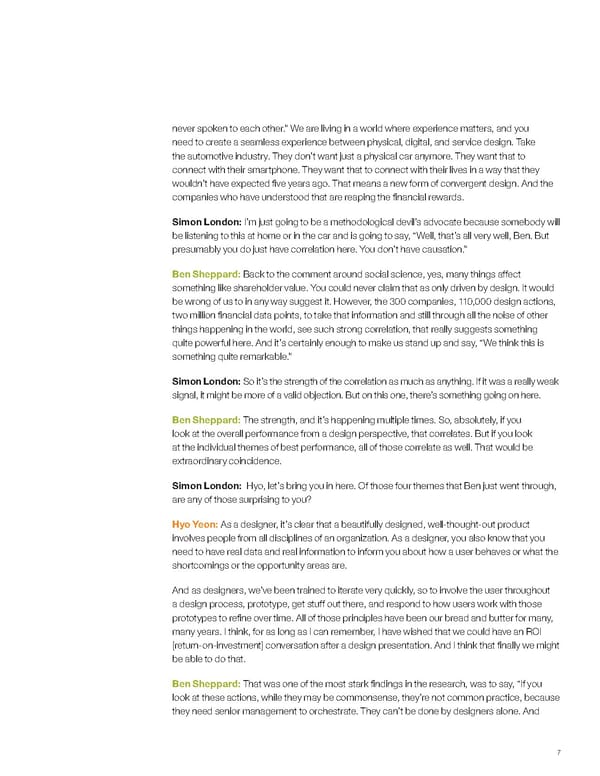never spoken to each other.” We are living in a world where experience matters, and you need to create a seamless experience between physical, digital, and service design. Take the automotive industry. They don’t want just a physical car anymore. They want that to connect with their smartphone. They want that to connect with their lives in a way that they wouldn’t have expected five years ago. That means a new form of convergent design. And the companies who have understood that are reaping the financial rewards. Simon London: I’m just going to be a methodological devil’s advocate because somebody will be listening to this at home or in the car and is going to say, “Well, that’s all very well, Ben. But presumably you do just have correlation here. You don’t have causation.” Ben Sheppard: Back to the comment around social science, yes, many things affect something like shareholder value. You could never claim that as only driven by design. It would be wrong of us to in any way suggest it. However, the 300 companies, 110,000 design actions, two million financial data points, to take that information and still through all the noise of other things happening in the world, see such strong correlation, that really suggests something quite powerful here. And it’s certainly enough to make us stand up and say, “We think this is something quite remarkable.” Simon London: So it’s the strength of the correlation as much as anything. If it was a really weak signal, it might be more of a valid objection. But on this one, there’s something going on here. Ben Sheppard: The strength, and it’s happening multiple times. So, absolutely, if you look at the overall performance from a design perspective, that correlates. But if you look at the individual themes of best performance, all of those correlate as well. That would be extraordinary coincidence. Simon London: Hyo, let’s bring you in here. Of those four themes that Ben just went through, are any of those surprising to you? Hyo Yeon: As a designer, it’s clear that a beautifully designed, well-thought-out product involves people from all disciplines of an organization. As a designer, you also know that you need to have real data and real information to inform you about how a user behaves or what the shortcomings or the opportunity areas are. And as designers, we’ve been trained to iterate very quickly, so to involve the user throughout a design process, prototype, get stuff out there, and respond to how users work with those prototypes to refine over time. All of those principles have been our bread and butter for many, many years. I think, for as long as I can remember, I have wished that we could have an ROI [return-on-investment] conversation after a design presentation. And I think that finally we might be able to do that. Ben Sheppard: That was one of the most stark findings in the research, was to say, “If you look at these actions, while they may be commonsense, they’re not common practice, because they need senior management to orchestrate. They can’t be done by designers alone. And 7
 Tapping into the business value of design Page 6 Page 8
Tapping into the business value of design Page 6 Page 8